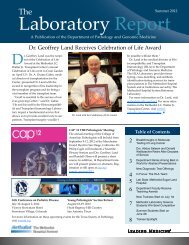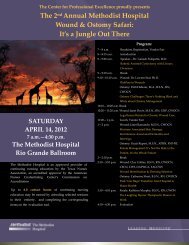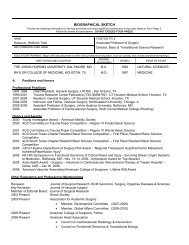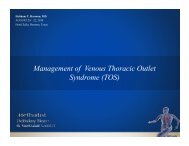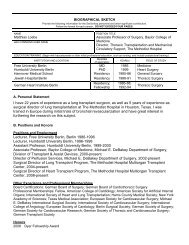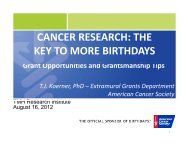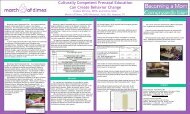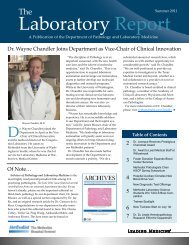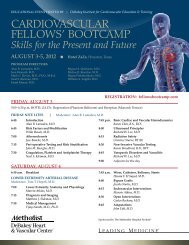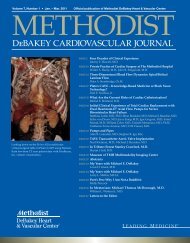The Facts Karla M. Ku - The Methodist Hospital
The Facts Karla M. Ku - The Methodist Hospital
The Facts Karla M. Ku - The Methodist Hospital
You also want an ePaper? Increase the reach of your titles
YUMPU automatically turns print PDFs into web optimized ePapers that Google loves.
P E R OX I S O M E P R O L I F E R ATO R - AC T I VAT E d<br />
R E C E P TO R S ( P PA R ) : A P OT E N T I A L S T R AT E GY TO<br />
C O M B AT L I P OTOX I C H E A R T d I S E A S E<br />
Q i T i a n , P h i l i p M . B a r g e r<br />
F r o m W i n t e r s C e n t e r f o r H e a r t F a i l u r e R e s e a r c h , B a y l o r C o l l e g e o f M e d i c i n e<br />
a n d Te x a s H e a r t I n s t i t u t e , S t L u k e’s E p i s c o p a l H o s p i t a l , H o u s t o n , Te x a s<br />
IntRoduCtIon<br />
obesity has been increasing dramatically in developed countries, which portends a higher incidence of cardiovascular<br />
risk factors such as insulin resistance, type 2 diabetes and hypertension. accumulating evidence shows that<br />
the occurrence of heart disease in obesity is associated with the systemic dysregulation of lipid metabolism and not<br />
necessarily with hypertension and coronary artery disease. the impaired lipid metabolism may lead to cardiac lipid<br />
accumulation or “lipotoxic heart disease.” 1 this is also encountered in diabetic cardiomyopathy and in late stages of<br />
heart failure when global cardiac energy production is impaired. the accumulation of excess lipids has been known to<br />
cause cell dysfunction and/or cell death in non-adipose tissues such as the pancreas, although it is unknown whether<br />
a direct link between lipid accumulation and cell death occurs in the heart. nevertheless, prevention or antagonism of<br />
cardiac lipid accumulation may serve as an adjunctive therapy for a variety of heart disorders that are accompanied<br />
by metabolic derangement.<br />
m e C H a n I s m s o f<br />
l I P o t o X I C H e a R t d I s e a s e<br />
Normally, fatty acid (FA) supply is<br />
tightly coupled to need in non-adipose<br />
cells, leaving little or no unoxidized FAs<br />
in these cells. In pathological states such<br />
as obesity or overnutrition, circulating<br />
FA levels increase and thus oversupply<br />
FAs to non-adipose cells. After entering<br />
cells, FAs are esterified to fatty acyl-<br />
CoAs and then transported across the<br />
mitochondrial membrane to undergo<br />
b-oxidation, producing acetyl CoA that<br />
enters the tricarboxylic acid cycle and<br />
yields ATP. If FA overload is imposed<br />
and/or FA utilization is suppressed or<br />
impaired, the fatty acyl-CoAs can accumulate<br />
in the cytoplasm. <strong>The</strong>se excess<br />
fatty acyl-CoAs will be diverted to<br />
synthesize triglycerides (TG), which<br />
are relatively inert and keep fatty acyl-<br />
CoAs away from pathways leading to<br />
apoptosis. When the content of intracellular<br />
fatty acyl-CoAs exceeds the<br />
TG storage capacity, which is limited<br />
in cardiac myocytes, fatty acyl-CoAs<br />
enter nonoxidative pathways such as<br />
ceramide synthesis. Ceramide has long<br />
been implicated in FA-induced apoptosis<br />
in non-adipose cells and could<br />
predictably result in loss of cardiac function.<br />
<strong>The</strong> accumulated acyl-CoAs also<br />
disrupt the insulin-signaling cascade<br />
that normally causes movement of<br />
glucose transporter 4 to the cell surface,<br />
resulting in impaired glucose uptake<br />
and cellular insulin resistance. <strong>The</strong> fates<br />
of fatty acyl-CoAs in cardiomyocytes<br />
are summarized in Figure 1.<br />
K e Y R o l e o f P Pa R s<br />
I n C a R d I a C l I P I d<br />
m e ta B o l I s m<br />
It has been well established that FA<br />
metabolism is transcriptionally<br />
regulated by peroxisome proliferatoractivated<br />
receptors (PPARs), members<br />
of the ligand-activated nuclear<br />
receptor superfamily. 2 PPAR isoforms<br />
heterodimerize with the retinoid-<br />
X receptor (RXR) for binding to a<br />
conserved specific DNA sequence in<br />
the promoters of PPAR target genes<br />
and then activate transcription. To<br />
date, three PPAR isoforms — a, b/δ<br />
and γ have been identified with<br />
specific tissue distribution; PPARa<br />
and b/δ are abundantly expressed in<br />
cardiac myocytes. Activation of PPAR<br />
transcriptional complexes occurs via<br />
binding of ligands, including both<br />
naturally occurring long-chain FAs<br />
and synthetic compounds such as the<br />
fibrate class of hypolipidemic drugs.<br />
In the heart, activation of PPARa and<br />
b/δ increases the expression of genes<br />
involved in cellular FA uptake as well<br />
as mitochondrial and peroxisomal boxidation,<br />
3 thus creating a positive<br />
feedback loop to handle the normal<br />
flow of intracellular FAs.<br />
<strong>The</strong> important role of PPARa and<br />
b/δ in cardiac physiology has been illustrated<br />
in genetically engineered mice.<br />
Heart-restricted PPARb/δ knockout<br />
mice exhibit a considerable reduction<br />
of FA oxidative capacity and undergo<br />
progressive accumulation of neutral<br />
lipids in the heart. 4 Similarly, systemic<br />
PPARa knockout mice have lower<br />
constitutive cardiac expression of FA<br />
oxidative enzymes and exhibit agedependent<br />
histological abnormalities<br />
such as contraction band necrosis and<br />
myocardial fibrosis when compared<br />
with wild-type controls. 5 In the fasting<br />
state, stored triglycerides in adipose<br />
tissue are hydrolyzed to release FAs that<br />
are taken up by the liver, heart or other<br />
tissues to yield ATP. However, this<br />
22 II (1) 2006 | JMDHC



